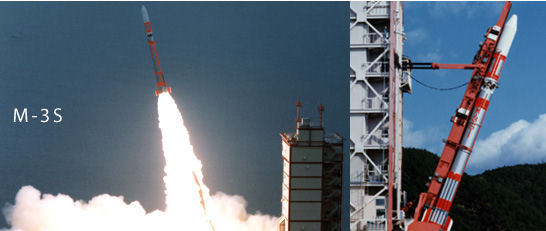M-3S
The third generation of the Mu series was M-3S rocket. It could send a 300 kg satellite into low earth orbit. The flight results during the 1st stage burning of M-3S-1 and 2 showed a slight pitch and yaw vibration due to the uncertainty of the bending parameters of the structure. In M-3S-3, the compensation circuit in the feed-back loop was modified and the vibration was suppressed, while an overshoot was observed immediately after the control started. In M-3S-4, further improvement was added to the feed-back compensator design and the flight result was satisfactory.
Tansei 4 was launched by Japan 1980-02-17. The objectives of this launching were for the confirmation of the new satellite launcher M-3S rocket and testing of new technology for future satellites. All onboard instruments operated satisfactorily.
The main objective of the HINOTORI mission [Launch Date: 1981-02-21] was the detailed study of solar flares during solar maximum. Principal investigations were (1) imaging of solar flare X rays in the range 10 to 40 keV by means of rotating modulation collimators and (2) spectroscopy of X-ray emission lines from highly ionized iron in solar flares in the range 1.7 to 2.0 A by means of a Bragg spectrometer. Wavelength scanning was achieved by the spacecraft revolution, with an offset pointing of the spin axis with respect to the sun. Investigations (1) and (2) each had a time resolution of 6 s. In addition, the following investigations were included: three solar flare X-ray monitors that recorded the time profile and spectrum of the X-ray flares in the range 2 to 20 keV, a solar flare gamma-ray detector for the range 0.2 to 9.0 MeV, a particle detector that monitored electron flux above 100 keV, and plasma probes for the measurement of electron density and temperature.
Astro B was the second Japanese X-ray astronomy satellite. After launch on February 20, 1983, it was renamed Tenma (Japanese for "Pegasus"). Tenma carried GSFC detectors which had an improved energy resolution (by a factor of 2) compared to proportional counters and performed the first sensitive measurements of the iron spectral region for many astronomical objects.
ASTRO-E was to be the Japan's fifth X-ray astronomy mission, but was unfortunately lost during launch (10 Feb 2000). Astro-E was developed at the Japanese Institute of Space and Astronautical Science (ISAS) in collaboration with the US and Japanese institutions. Astro-E was to carry, among other instruments, a new type of X-ray spectrometer, the X-ray micro-calorimenter, which provides an unprecendent energy resolution compared to non-dispersive instruments.
X-ray telescopes (XRTs) of nested thin foil mirrors are developed for Astro-E, the fifth Japanese x-ray astronomy satellite. Although the launch was not successful, the design concept, fabrication, and alignment procedure are summarized. The main purpose of the Astro-E XRT is to collect hard x rays up to 10 keV with high efficiency and to provide medium spatial resolution in limited weight and volume. Compared with the previous mission, Advanced Satellite for Cosmology and Astrophysics (ASCA), a slightly longer focal length of 4.54.75 m and a larger diameter of 40 cm yields an effective area of 1750 cm2 at 8 keV with five telescopes. The image quality is also improved to 2-arc min half-power diameter by introduction of a replication process. Platinum is used instead of gold for the reflectors of one of the five telescopes to enhance the high-energy response.
The purpose of the Ohzora mission [Launch Date: 1984-02-14] was to perform remote sensing of the minor constituents of the middle atmosphere and to study the wave-particle interactions in the ionospheric plasma in the South American anomaly and the auroral zones. This mission is part of the Middle Atmosphere Program (MAP).
The vehicle M-3S-1 is described as follows
| 1st st. | SOB | 2nd st. | 3rd st. | ||
|---|---|---|---|---|---|
| Total length | m | 23.801 | 5.794 | 8.895 | 2.501 |
| Maximum diameter | m | 1.410 | 0.310 | 1.410 | 1.135 |
| Weight (ig.) | kg | 45379.4*1 | 4122.4 | 11076.8*3 | 1416.0 |
| Weight (b.o.) | kg | 18082.3*2 | 1375.7 | 3862.8 | 330.2 |
| Propellant weight | kg | 27144.0 | 2746.7 | 7214.0 | 1085.8 |
| Freon | kg | 306.3 | 42.0 | ||
| Hydrazine | kg | 28.0 | |||
| Mass ratio | 2.744 | 2.874 | 4.170 | ||
| Specific Impulse | sec | 266*5 | 219*4 | 277*5 | 284*5 |
| Center of gravity (ig.) | % | 58.95 | 66.27 | 77.97 | |
| Center of gravity (b.o.) | % | ||||
| Ix (ig.) | kg.m.sec2 | 1839.0 | 305.8 | 18.60 | |
| Ix (b.o.) | kg.m.sec2 | 660.0 | 105.2 | 3.30 | |
| Iy (ig.) | kg.m.sec2 | 188106.0 | 3257.9 | 46.90 | |
| Iy (b.o.) | kg.m.sec2 | 83111.0 | 1927.8 | 23.00 | |
| Net payload | kg | 145.7 | SA 185.0 | ||
| Gross payload | kg | 148.2 | |||
| Nozzle expansion ratio | 7.75 | 3.57 | 21.98 | 41.53 | |
| Nozzle exit diameter | mm | 1267.0 | 302.2 | 1078.3 | 696.0 |
*1:including Freon(306.3kg)
*2:including Freon(153.15kg)
*3:including Freon & H2O2
*4:in atmosphere
*5:in vacuum

|
NEWSLETTER
|
| Join the GlobalSecurity.org mailing list |
|
|
|

